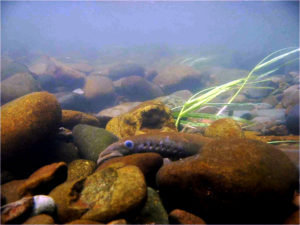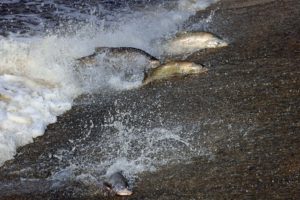Yes, the silver and pink flashers are in Tomales Bay and are working their way up Marin County creeks to spawn in their native waterways. Paola Bouley, conservation director for the Salmon Protection and Watershed Network (SPAWN), reported seeing coho spawners on October 21, 2009.
Chris Pincetich, SPAWN’s watershed biologist, and his colleagues estimate a return of 200 to 300 coho salmon this year in the Lagunitas Creek watershed, a big improvement overlast year’s run but a drop in the bucket when compared to historical runs. The group is beginning its tenth year of naturalist-led creek walks on what’s now our state’s largest remaining coho run, so now’s the time to see the salmon migrating upstream.
This summer, after last year’s disastrously low rainfall, SPAWN members rescued dozens of baby coho stranded in pools by low stream flow and moved them downstream to continue their out-migration to the open ocean, where they will spend a year and a half of their three-year lifecycle. Now, after two good rains, the streams are running again, and the annual upstream migration has begun.
Numbers, though, are extremely low. Salmon have been declining in California since the Gold Rush, when mines sent massive loads of sludge and debris into steams and began destroying fish habitat. The process continues with urbanization, pollution from agricultural chemicals, damming and diversion of waterways, suburban migration barriers, and rising temperatures. According to the California Department of Fish and Game, in the 1940s 200,000 to 500,000 coho filled coastal streams. In 1991 DFG found them at risk of extinction.
Today, coho are federally listed as “endangered” in Central California and state listed as “threatened” to north of Mendocino County. Numbers are so low that the Pacific Fishery Management Council has banned commercial salmon fishing off California for coho since the 1990s and now has banned all salmon fishing for the second year in a row, with a 10-day window for sport fishing.
But up and down the coast grassroots groups like SPAWN are cleaning up streams, taking out invasive plants that choke waterways, and planting native species, improving or recreating the riparian habitat coho have evolved to thrive in and will return to with their unerring sense of smell.
When the coho move up into the estuary, they stop eating, and will not eat again during their migration and spawning, which may take up to a month and a half. When they receive the right chemical signals, they will return to their native streams, swimming against the current, leaping over boulders, crashing through rapids, relentlessly making their way upstream.
When a female finds a suitable spot in shallow water rushing over cobbles (“Head of a riffle, tail of a pool,” says Pincetich), she will lay on her side, flapping her tail to build a nest called a redd, flinging four-to-six inch cobbles with her tail, allowing the current to wash away the silt. When she is ready, the males will cross over her, back and forth, quivering. She will squeeze out her eggs, and instantly one or more males will rush along her flanks and release milt as close to the female’s vent as possible. She will now bury the eggs, and for a few days she will guard the nest. Then she will weaken, drift downstream and die. The males also die within a few days.
Completing their cycle, salmon form a critical connection between ocean and inland watersheds. After spawning, when salmon die and decompose or are eaten by one of the dozens of wildlife species that depend on salmon, they recycle ocean nutrients to the inland watersheds.
You can sign up for a SPAWN naturalist-led walk on Lagunitas Creek in Marin County and view coho spawning through January by clicking here.

.jpg)



